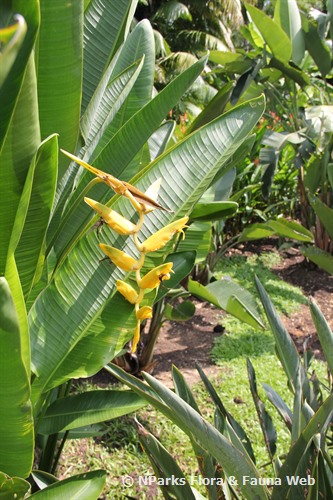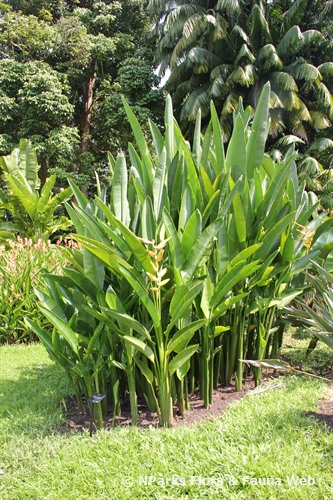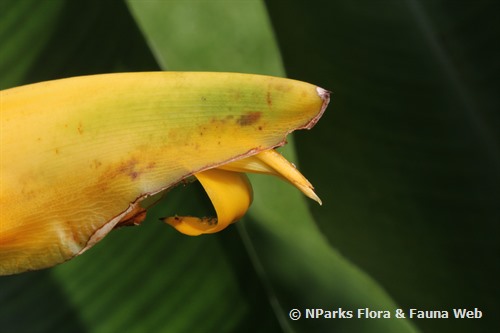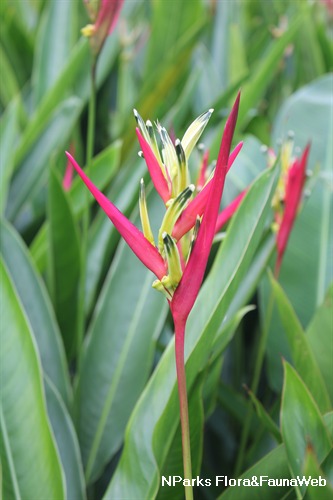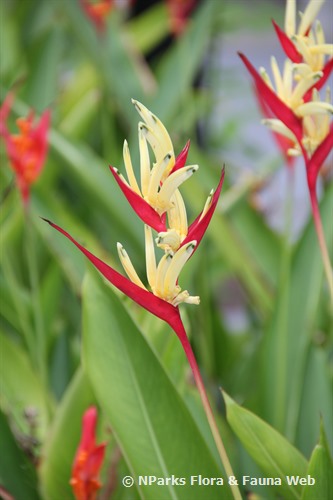
Back
Heliconia marginata 'Lutea'
| Family Name: | Heliconiaceae |
| Common Name: | Yellow Pendent Heliconia, Golden Pendent Heliconia, Golden Marginate Heliconia, 蝎尾蕉 |
Heliconia marginata 'Lutea', or known as Yellow Pendent Heliconia, is a large herbaceous plant that can reach 1.5 - 4.5 m tall. It produces a pendulous inflorescence with yellow bracts and hidden yellow flowers. It grows best in moist, well-drained soil in full sun or semi-shade and tolerates brief waterlogging.
Name
Classifications and Characteristics
| Plant Division | Angiosperms (Flowering Seed Plants) (Monocotyledon) |
|---|---|
| Plant Growth Form | Herbaceous Plant |
| Lifespan (in Singapore) | Perennial |
| Mode of Nutrition | Autotrophic |
| Maximum Height | 1.5 m to 4.5 m |
Biogeography
| Native Habitat | Terrestrial |
|---|---|
| Preferred Climate Zone | Tropical |
| Local Conservation Status | Non-native (Horticultural / Cultivated Only) |
Description and Ethnobotany
| Growth Form | It is a rhizomatous, herbaceous plant, growing up to 1.5–4.5 m tall. |
|---|---|
| Foliage | The leaves are large, erect, paddle-shaped, and dark green, resembling banana leaves (musoid). |
| Stems | The erect aboveground 'stems' are pseudostems (shoots formed from a series of leaf sheaths tightly wrapped around one another), reaching 1.5–4.5 m tall. The true stems are underground ginger-like rhizomes (thick, horizontal modified stems). |
| Flowers | The inflorescence is a pendulous panicle with 5–15 bracts arranged in a spiral or slightly alternately along the rachis (main stem of the inflorescence). The bracts and rachis are golden yellow, with the distal end of the bracts being tinged green. Each bract subtends a cluster of hook-like, tubular, waxy, yellow flowers. The inflorescence is borne at the ends of the pseudostems. |
| Cultivation | It grows best in moist, well-drained soil in full sun or semi-shade. It can tolerate brief waterlogging. Apply fertiliser generously every 2–3 months to promote healthy growth. It can be propagated by division. |
| Etymology | The genus Heliconia is named after Mount Helicon in Greece, the supposed home of Apollo and the mythological Muses. |
| Ethnobotanical Uses | Cut - Dried Flower: The inflorescence is occasionally used in floral arrangements. |
Landscaping Features
| Desirable Plant Features | Ornamental Flowers, Ornamental Foliage |
|---|---|
| Landscape Uses | General, Parks & Gardens, Hedge / Screening, Focal Plant, Swimming Poolside |
| Thematic Landscaping | Golden Garden |
Fauna, Pollination and Dispersal
| Fauna Pollination Dispersal Associated Fauna | Bird-Attracting (Flowers) |
|---|
Plant Care and Propagation
| Light Preference | Full Sun, Semi-Shade |
|---|---|
| Water Preference | Lots of Water |
| Plant Growth Rate | Moderate |
| Rootzone Tolerance | Moist Soils, Well-Drained Soils, Fertile Loamy Soils, Waterlogged Soils (Drains Site) |
| Transplanting Tolerance | Moderate |
| Maintenance Requirements | Low |
| Pest(s) | Sucking Insects, Chewing Insects |
| Propagation Method | Division, Storage Organ (Rhizome) |
Foliar
| Foliage Retention | Evergreen |
|---|---|
| Mature Foliage Colour(s) | Green |
| Mature Foliage Texture(s) | Smooth |
| Foliar Modification | Flower/Fruit Bract |
| Foliar Type | Simple / Unifoliate |
| Foliar Arrangement Along Stem | Alternate |
| Foliar Shape(s) | Non-Palm Foliage (Lanceolate) |
| Foliar Margin | Entire |
| Leaf Area Index (LAI) for Green Plot Ratio | 3.5 (Shrub & Groundcover - Monocot) |
Non - Foliar and Storage
| Root Type | Underground (Fibrous Root) |
|---|---|
| Specialised Storage Organ(s) | Underground (Rhizome) |
Floral (Angiosperm)
| Flower & Plant Sexuality | Bisexual Flowers |
| Flower Colour(s) | Yellow / Golden |
|---|---|
| Flower Texture(s) | Thick / Fleshy |
| Flower Grouping | Cluster / Inflorescence |
| Flower Location | Terminal |
| Individual Flower Shape | Tubular |
| Inflorescence Type | Panicle |
| Flowering Period | Free-Flowering |
| Flowering Habit | Polycarpic |
References
| References | Berry, F.Y. & Kress, W.J. (1991) Heliconia: An Identification Guide. Smithsonian Institute Press, London. |
|---|
Image Repository
Others
| Master ID | 33727 |
|---|---|
| Species ID | 8141 |
| Flora Disclaimer | The information in this website has been compiled from reliable sources, such as reference works on medicinal plants. It is not a substitute for medical advice or treatment and NParks does not purport to provide any medical advice. Readers should always consult his/her physician before using or consuming a plant for medicinal purposes. |

